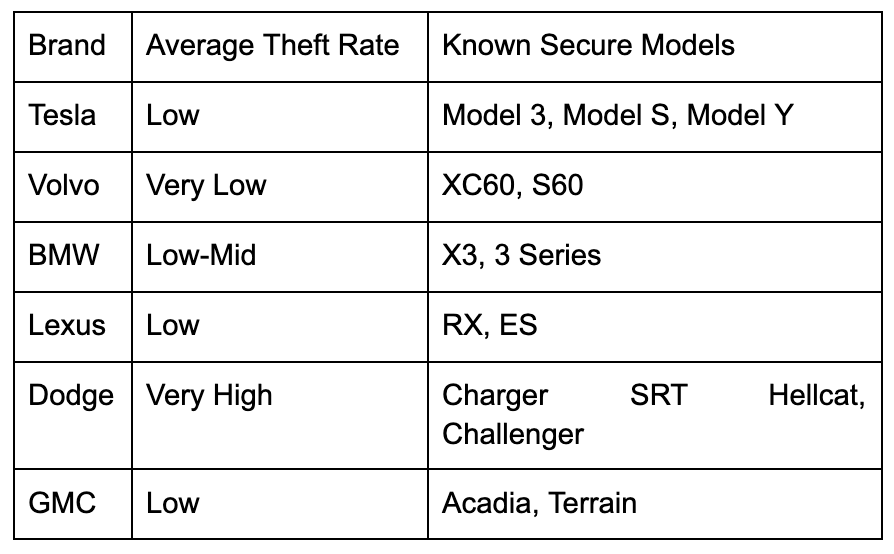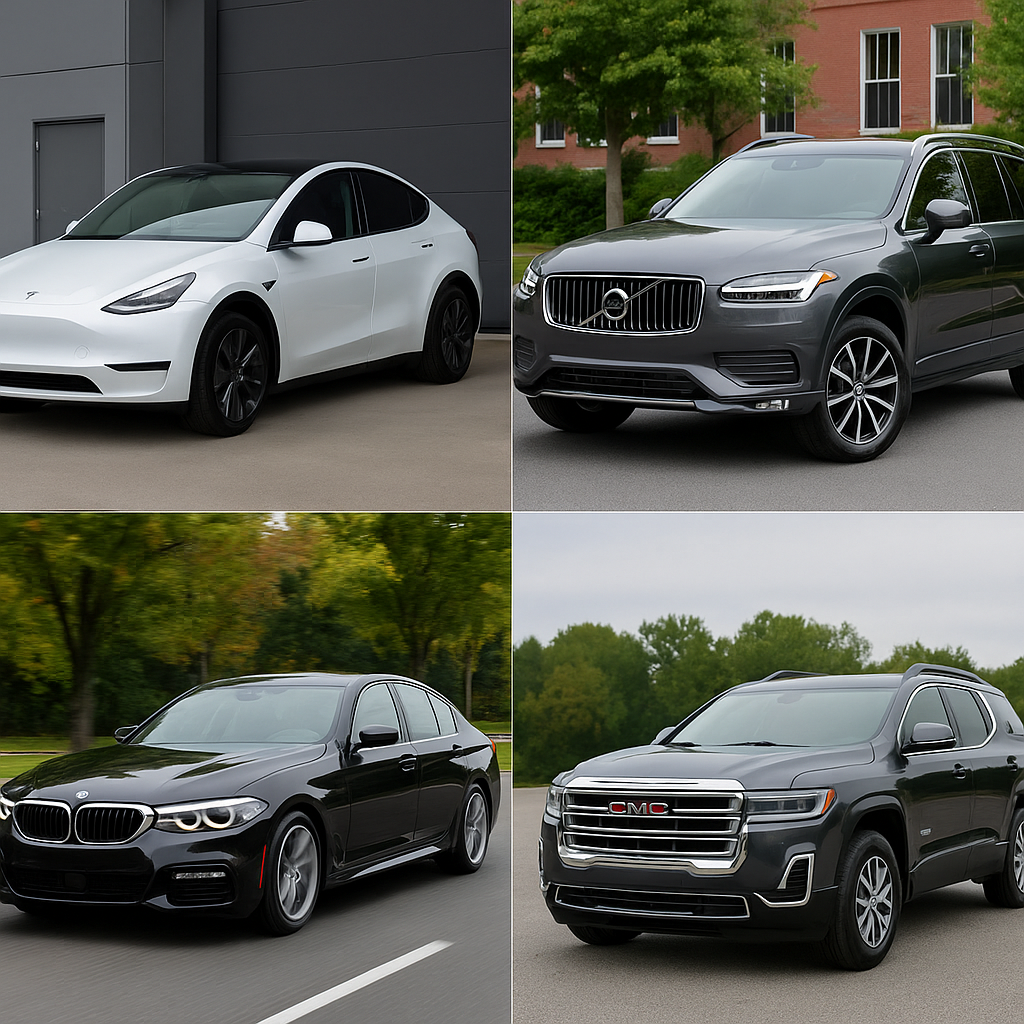Car theft isn't just a hassle - it's a violation. The thought of walking into a parking lot only to find an empty space where your vehicle once stood is enough to unsettle any driver. In the United States, tens of thousands of cars are stolen each year. But some vehicles seem to repel thieves like magnets turned the wrong way.
Which cars are they? What features help protect them? What trends contribute to theft statistics? Let's uncover the truth behind the least stolen vehicles in America.
Understanding VINs and Theft Risk
Every vehicle carries a unique VIN - Vehicle Identification Number. It helps verify the vehicle's identity, ownership, and accident history. Curious about a specific car's record? Complete Car History Report | Vininspect to instantly access security data, model features, and theft history.
This tool gives buyers and drivers the upper hand in staying safe and making smarter vehicle choices.
Why Knowing the Least Stolen Cars Matters
Theft prevention is more than locking doors or parking under streetlights. Some car models are statistically less likely to be targeted by thieves. Whether you're planning to buy a new vehicle or simply want peace of mind, choosing from the least stolen vehicles can make a real difference.
This insight isn't just practical - it's backed by claims data, insurance reports, and security research. Drivers aren't only asking what's affordable or stylish anymore. Now, they're asking: what is the least stolen car in America?
Why Theft Rates Vary Between Car Models
Different cars have different levels of vulnerability. But why?
Some models lack modern anti-theft devices. Others are high-demand targets on the black market. Certain vehicles are easier to steal due to outdated ignition systems, or because thieves can unlock them in seconds with cloned key fobs.
At the same time, tech-savvy designs with GPS tracking and biometric access make theft nearly impossible - raising the bar for auto thieves.
Top Features That Help Prevent Theft
The least stolen autos often come with several layers of protection:
- Encrypted key fobs
- Biometric driver recognition
- Real-time GPS tracking
- Immobilizer systems
- Reinforced ignition security
- PIN code access for start-up
These features don't guarantee a theft-free future, but they certainly protect what you own - and discourage amateur criminals.
Tesla's Unlikely Status: Least Stolen Yet Popular
You might think electric vehicles would be easy targets, but Tesla models buck the trend. Despite being some of the most popular electric vehicles on the road, Teslas are among the least stolen vehicles in the United States.
Why?
Tesla Model 3, Model S, and Model Y are armed with always-on GPS tracking, over-the-air alerts, and multi-factor app verification. Tesla owners can track their car in real time - giving thieves almost no chance of disappearing without a trace.
Volvos: The Quiet Champion in Theft Resistance
Volvo doesn't just build safe vehicles for crashes. They also produce cars that thieves avoid. The combination of PIN-code ignition, secure doors, and proprietary locking systems makes it extremely difficult to unlock a Volvo without the correct key.
Owners of Volvo models such as the S60 and XC90 report few claims of theft, even in urban areas. That speaks volumes.
BMWs With Bulletproof Security
Another surprise? BMW models are also among the least stolen in the country. Cars like the BMW X5 and 3 Series include sophisticated encryption protocols that prevent cloning of key signals.
Additionally, many newer BMWs have anti theft devices and smart proximity sensors that shut off internal systems when unusual activity is detected - adding layers of security without inconvenience.
Lexus Models Drive Thieves Away
Though Lexus cars are known for luxury, they're also known for low theft rates. The Lexus RX and ES models rank consistently low on the stolen vehicles index. One reason is brand emphasis on layered digital security and driving control systems that alert owners instantly to intrusion.
Which Model Year Plays a Role?
Data shows that newer model years of the same car are often harder to steal than older ones. For example, a 2024 Toyota Camry might include advanced GPS tracking, biometric access, and smartphone-linked alarms - features not found in its 2014 counterpart.
Insurance data confirms that modern vehicles, especially EVs, are less prone to theft due to tech advancements.
Cars That Thieves Don't Want
Let's look at models consistently avoided by car thieves across the United States:
- Tesla Model Y
- BMW 3 Series
- Volvo XC90
- GMC Acadia
- Lexus RX 350
These vehicles not only deliver performance but remain unappealing to criminals. Why? They're either too traceable, too hard to break into, or too unfamiliar in the stolen parts market.
When Claims Data Speaks Louder Than Words
Every insurance report contains thousands of claims - and these tell a powerful story. Compared to dodge muscle cars, for instance, many EVs show drastically lower theft claims.
Take the Dodge Charger SRT Hellcat. Despite its horsepower and appeal, it's one of the most stolen vehicles in the USA. In comparison, a Tesla Model 3 with lower horsepower is rarely touched.
Why Car Thieves Avoid Certain Models
Car thieves are opportunists. They prefer models they can steal fast, sell quickly, and strip for parts without triggering alarms. Vehicles with strong security systems or low resale value of parts are simply not worth the risk.
High-theft cars tend to lack immobilizers, have universal ignition designs, or weak windows and doors. Meanwhile, the least stolen models are often ones where breaking in or bypassing systems takes too long - even seconds matter.
High-Risk Models Compared to Theft-Resistant Cars
It's eye-opening to compare high-theft cars to theft-resistant vehicles:
- Dodge Charger SRT Hellcat: A magnet for thieves, particularly due to its resale parts and street appeal. Despite anti-theft tech, it's frequently stolen.
- GMC Acadia: Though not luxury-tier, it resists theft due to low black market demand and solid security.
- Volvo XC60: Quiet, unflashy, and wrapped in tech. Not worth the effort for a typical guy looking to steal and flip.
These cars highlight how brand, design, and technology all play a role in how prone a vehicle is to theft.
How Driving Habits Affect Theft Risk
Interestingly, driving habits also contribute to whether a car remains safe:
- Vehicles often parked in well-lit areas are less likely to be stolen.
- Leaving key fobs inside or failing to lock doors increases theft risk dramatically.
- Long-term charging stations for EVs make them harder to tow or remove quickly - especially in Tesla models.
Being mindful of how and where you leave your vehicle goes a long way toward keeping it out of thieves' hands.
Best Practices to Protect Your Vehicle
Even if your car is on the least stolen list, there's no reason to get comfortable. To protect your vehicle, use these proven techniques:
- Install third-party GPS tracking systems
- Use steering wheel locks as a visual deterrent
- Park in monitored garages whenever possible
- Use RFID-blocking pouches to secure digital key fobs
- Never leave your engine running while unattended
Staying alert is as important as the security tech your car includes.
Anti-Theft Devices Worth Installing
Aside from factory systems, additional anti theft systems can dramatically reduce your risk:
- Kill switches prevent ignition without a hidden button or PIN
- Wheel clamps keep cars immobile even if doors are opened
- Hood locks deter battery theft and ECU tampering
- Window sensors detect glass breakage within seconds
Modern thieves may use laptops and signal repeaters, but a layered defense still wins.
Real Recovery Stories Prove the System Works
Drivers whose vehicles were stolen but later recovered often cite one thing: digital defense. Thanks to VIN tracking, smartphone alerts, and onboard cameras, many Tesla owners have helped police track their cars within hours.
In one example, a stolen Tesla Model Y was tracked across three counties and stopped within 30 minutes. The driver received alerts directly to his phone - including the exact road location.
Charging Forward with EV Theft Resistance
Electric vehicles are not just cleaner - they're harder to steal. Limited range without charging, specialized parts, and app-connected driving controls make them difficult targets.
Plus, EVs often come with advanced connectivity and security tools that traditional gas-powered cars lack. For thieves, this means longer jobs, higher risk, and often, no payoff.
How to Verify a Car's Theft History
Before buying a used vehicle, always verify its background. Has it been previously stolen? Recovered? Involved in suspicious claims?
Use a trusted VIN tool to uncover the truth. A VIN decoder online can show you:
- Past theft or recovery records
- Ownership chain
- Previous claims
- Model years, factory options, and security ratings
- Whether the car was flagged by insurance companies
Transparency here saves you from investing in a future problem.
The Role of Property Crime in Auto Thefts
Many auto thefts are part of larger property crime networks. Cars are often used in follow-up burglaries or stolen to order for chop shops. Understanding that your vehicle might be a tool for a bigger crime makes choosing secure models even more critical.
Comparing Theft Statistics by Brand
Below is how some brands stack up in theft rankings, compared to others:

Data varies by state, but patterns remain. Thieves love certain cars - others, they don't even glance at.
Do Car Thieves Prefer Speed or Simplicity?
Most modern car thieves are looking for one thing: fast, simple access. If a vehicle takes more than 60 seconds to break into or start, it's usually abandoned.
That's why dodge muscle cars remain highly targeted - they're fast and valuable, but vulnerable. In contrast, Teslas require multi-step authentication and remain traceable - even across borders.
FAQ
Can my car still be stolen if it's on the least stolen list?
Yes. No vehicle is 100% safe. But certain models dramatically reduce the odds by making theft harder and recovery easier.
Is it true that electric vehicles are harder to steal?
Yes. Electric vehicles like Tesla have built-in tracking, phone-controlled systems, and limited range when unlinked from an owner's account.
Are older model years more prone to theft?
Absolutely. Older cars lack many modern security features and often don't have immobilizers or GPS.
Why is the Dodge Charger SRT Hellcat stolen so often?
It's a high-horsepower performance model with massive street value. Thieves love them for parts and quick resale.
Can I reduce my insurance rate by owning the least stolen car?
Yes. Insurance report data influences premiums. Owning a vehicle with a low theft rate can lower claims risk, which may save money.
